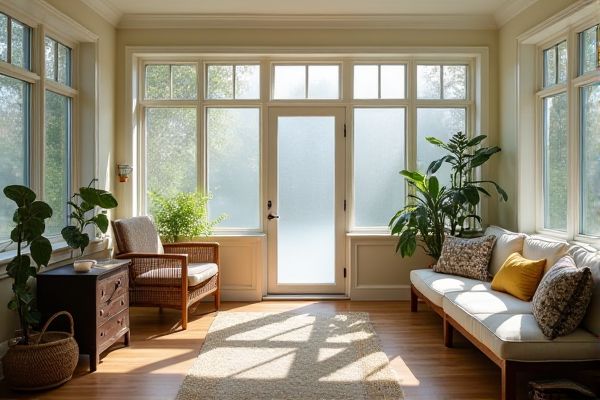
Translucent shade panels diffuse natural light while maintaining privacy, ideal for sunrooms needing gentle illumination without glare; frosted glass, on the other hand, provides a textured, opaque surface that offers enhanced privacy and a sleek, modern look. Discover which option best suits Your sunroom design and functionality by reading the full article.
Table of Comparison
| Feature | Translucent Shade | Frosted Glass Sunroom |
|---|---|---|
| Light Control | Diffuses sunlight, reduces glare | Softens light, enhances privacy |
| Privacy | Moderate privacy | High privacy with obscured view |
| UV Protection | Blocks some UV rays | Blocks majority of UV rays |
| Energy Efficiency | Improves insulation moderately | Offers superior insulation, reduces heat loss |
| Maintenance | Easy to clean, replaceable | Requires regular cleaning, durable surface |
| Aesthetic Appeal | Modern, minimalistic look | Elegant, frosted textured appearance |
| Cost | More affordable option | Higher initial investment |
Introduction to Translucent Shade vs Frosted Glass Sunrooms
Translucent shade sunrooms utilize semi-transparent materials that diffuse natural light while maintaining privacy, enhancing energy efficiency by reducing heat gain. Frosted glass sunrooms feature glass treated with acid etching or sandblasting to create a textured, opaque surface that obscures visibility but allows soft light penetration. Both options provide unique aesthetics and functional benefits, ideal for homeowners seeking comfort and style in outdoor living spaces.
Understanding Translucent Shade Sunrooms
Translucent shade sunrooms utilize advanced, light-diffusing materials that provide optimal natural light while minimizing glare and heat buildup. These sunrooms balance privacy and brightness by allowing soft, filtered sunlight to penetrate, creating a comfortable indoor environment. In contrast, frosted glass sunrooms offer more obscured views with a matte finish that enhances privacy but reduces the clarity and intensity of sunlight entering the space.
Features of Frosted Glass Sunrooms
Frosted glass sunrooms feature privacy-enhancing panels that diffuse light while obscuring visibility, creating a soft, ambient interior atmosphere. The textured surface reduces glare and UV exposure, offering protection from harsh sunlight without sacrificing natural illumination. These sunrooms provide an elegant, modern aesthetic and improved energy efficiency through better heat insulation compared to clear or translucent glass options.
Light Diffusion: Translucent Shade vs Frosted Glass
Translucent shades offer adjustable light diffusion, allowing control over brightness while maintaining soft, filtered natural light in sunrooms. Frosted glass provides consistent light diffusion with a matte finish that evenly scatters sunlight, reducing glare but limiting light intensity. Both options enhance privacy while balancing illumination, with translucent shades providing dynamic light management and frosted glass delivering steady, diffuse lighting.
Privacy Considerations in Sunroom Design
Translucent shades provide adjustable privacy by diffusing light while still allowing visibility, offering a flexible solution for sunroom design. Frosted glass ensures permanent privacy by obscuring views completely, making it ideal for spaces where discreetness is a priority. Selecting the right option depends on your desired balance between natural light and privacy in the sunroom.
Energy Efficiency Comparison
Translucent shade sunrooms provide superior energy efficiency by diffusing natural light evenly, reducing heat gain and lowering cooling costs compared to frosted glass sunrooms. Frosted glass, while offering privacy, tends to trap more heat, leading to increased reliance on air conditioning systems. You can optimize your sunroom's energy performance by selecting translucent shades that balance light transmission and thermal insulation effectively.
Aesthetic Appeal and Design Options
Translucent shades offer versatile aesthetic appeal with adjustable light control and a sleek, modern look, enhancing your sunroom's design flexibility. Frosted glass provides a consistent, elegant diffusion of light that adds privacy and a soft, matte finish, ideal for minimalist or contemporary styles. Choosing between the two depends on whether you prioritize customizable ambiance or uniform, subtle illumination in your sunroom design.
Maintenance and Durability Differences
Translucent shades offer low maintenance by requiring simple cleaning and occasional dusting, while frosted glass sunrooms demand more frequent cleaning to prevent stains and maintain their appearance. Durability-wise, frosted glass provides better resistance to scratches and weather elements due to its tempered surface, whereas translucent shades can suffer from wear and fading over time. Your choice impacts long-term upkeep costs and the sunroom's ability to withstand environmental stress.
Cost Analysis: Translucent Shade vs Frosted Glass
Translucent shades generally offer a more cost-effective solution for sunrooms, with installation expenses ranging from $200 to $500 depending on material and size, while frosted glass panels typically cost between $50 to $150 per square foot, making initial investment significantly higher. Maintenance costs for translucent shades are lower due to ease of cleaning and replacement, whereas frosted glass requires periodic professional cleaning to maintain appearance, adding to overall lifecycle expenses. Evaluating long-term value, translucent shades provide energy savings through improved insulation, whereas frosted glass offers enhanced privacy and durability but demands greater upfront and upkeep costs.
Which Sunroom Solution Fits Your Needs?
Translucent shades provide adjustable light control and privacy for sunrooms, allowing you to customize brightness and protect furniture from UV damage while maintaining outdoor views. Frosted glass sunrooms offer consistent privacy and diffuse natural light evenly, creating a soft ambiance without glare or direct sunlight. Choosing between translucent shades and frosted glass depends on your preference for flexibility in light management versus a permanent, low-maintenance solution with uniform illumination.
 homyna.com
homyna.com